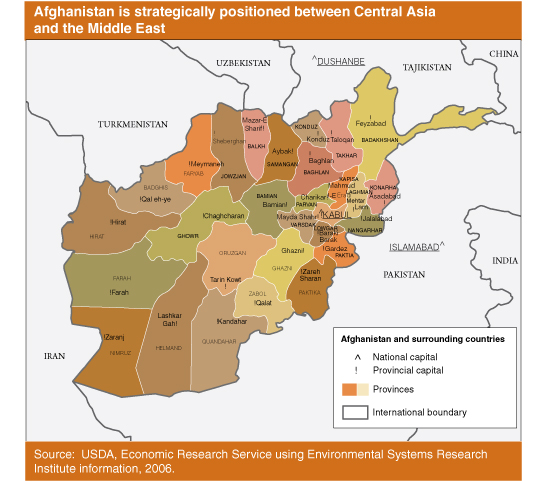Supply Disruptions Cause Price Spikes in Afghanistan’s Wheat Market
- by Suresh Persaud
- 6/1/2010
Afghanistan is a low-income, landlocked country with limited economic and physical access to food. Wheat is a key staple, with per capita consumption averaging nearly a pound per day. Rising wheat prices are a major threat to food security—wheat accounts for over half of the population’s caloric intake, and low per capita income limits purchasing power.
Domestic production is inadequate for meeting food needs and is also subject to sizable weather-induced fluctuations. Although Afghanistan imports wheat and flour from a number of neighboring countries, Pakistan tends to supply more than half of these imports. Weak transportation links limit Afghanistan’s access to international markets. Pakistan and Afghanistan share a border, and Pakistani mills extend credit to Afghan traders to purchase flour. The growth of Pakistan’s flour mills, driven in part by the availability of subsidized wheat from the Government, has been concentrated in provinces neighboring Afghanistan to take advantage of relatively higher prices.
Kazakhstan, the largest exporter of wheat in the region and, in recent years, a dominant flour exporter, does not share a border with Afghanistan. Kazakhstan’s wheat and flour exports to Afghanistan arrive via circuitous routes through bordering countries.
Poor growing conditions in 2008 sharply reduced Afghanistan’s wheat harvest to 1.5 million metric tons, approximately 60 percent below that of the previous year, so that consumer well-being depended critically on access to international markets. The wheat harvest in Pakistan, usually a reliable supplier of wheat and flour to Afghanistan, also declined in 2008, compelling Pakistan to import wheat. Moreover, increased conflict in major transport corridors along the Pakistani border hindered flour movements into Afghanistan.
Afghan wheat prices spiked, peaking at $751 (U.S. dollars) per metric ton in May 2008, far higher than in Pakistan and international markets. Substantial price increases in Afghanistan were needed to attract larger shipments of flour from Pakistan (despite an official export ban) and Kazakhstan through an inefficient transport system from the north. Kazakhstan’s exports to Afghanistan were not sufficient to fully offset the large contraction in Afghanistan’s 2008 wheat harvest.
Subsequent improvements in Afghanistan’s growing conditions suggest a record 2009/10 wheat harvest and a favorable shortrun outlook. Nevertheless, Afghanistan will remain subject to supply disruptions and price spikes as long as its domestic agricultural production is highly variable and weak transportation links limit its ability to diversify its sources of imported grain. Improvements in infrastructure could permit Afghanistan to obtain wheat and flour imports at a lower cost.
This article is drawn from:
- Price Volatility in Afghanistan’s Wheat Market, by Suresh Chand Persaud, Outlook Report No. WHS-10d-01. (2018). USDA, Economic Research Service.



